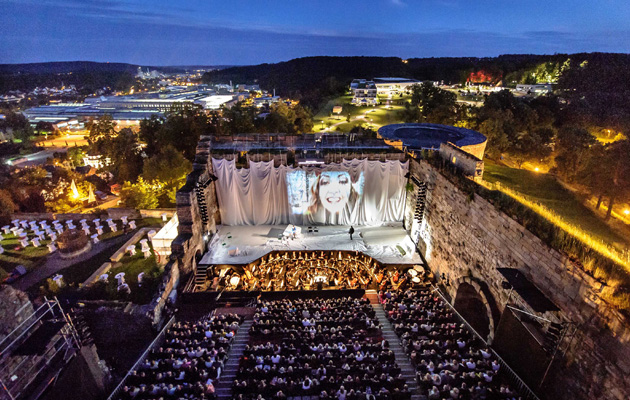ETC Eos Ti controls Heidenheim opera festival
Date Posted: 9/14/2016

Throughout July and August 2016, the German city of Heidenheim was devoted to the fine art of singing for its annual opera festival "Opernfestspiele Heidenheim". Performances including Puccini's
La Bohème
and Verdi's
Oberto
attracted a record crowd totalling more than 17,500 visitors. For this prestigious event, a Munich-based company, Scheinwurf GmbH, was appointed to supply the lighting system. The team, led by Managing Director Stefan Bettinger, selected equipment from ETC, including
Source Four
®
LED Series 2 Lustr
,
ColorSource
®
PAR
,
ETC network technology
and an
Eos Ti
®
lighting control desk.
The festival took place at various venues around the town. For
La Bohème
, the organisers secured an impressive open air location - the medieval, partly dilapidated ruins of the Knights' Hall of Hellenstein Castle. Another important venue was the Festival Hall of the Congress Centre Heidenheim, which played host to performances of Verdi's first opera,
Oberto
. The scenery impressed with subtle aesthetics, lit with eight Source Four LED Series 2 Lustr with CYC adapters, and 12 ColorSource PAR fixtures. "I chose the Lustr because we needed both white light and dark blue," says Bettinger. "And, the ColorSource PARs make no compromises in terms of white colour mixing and dimming, and they're more affordable than comparable lights."
For the first time at the festival, an ETC Eos Ti console was used to control the lighting. "The Eos Ti offers a huge range of functions. Both lighting professionals and novice users can easily work with this user-friendly console. For editing and manipulating cue lists, the Eos Ti is the best console on the market for theatre," says Bettinger.
For Opernfestspiele Heidenheim, a selection of videos with different line-ups were stored on a media server connected to the Eos Ti. Eos software includes a magic sheet function, which allows users set up customised, interactive live/blind displays. This proved to be a useful tool for Bettinger and his team, "using the magic sheets, the operator only had to press a button to activate the right video for that evening's performance."
The ETC Net3 DMX/RDM gateways chosen to provide data distribution offered several advantages. "On the one hand, I received RDM feedback from the ETC fixtures, on the other hand, I could use the DMX-hold function for the load out," says Bettinger. "Immediately after the shows, I shut down my console and the lights dimmed slowly over the course of an hour, so we were not rushed. In addition, in the outdoor area, we had three different locations for the consoles - one for programming, one to focus and one to drive the show - and because area-wide network connections were available, we did not need to rearrange a single DMX cable."
Photo credit: Oliver Vogel